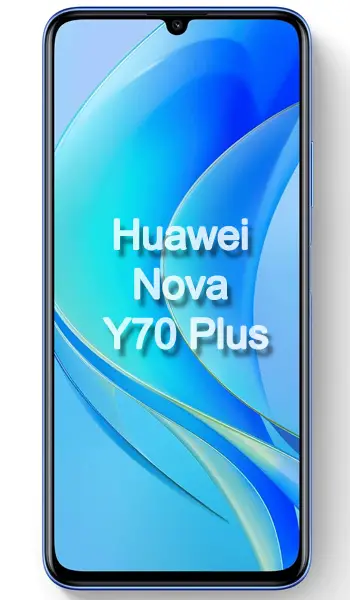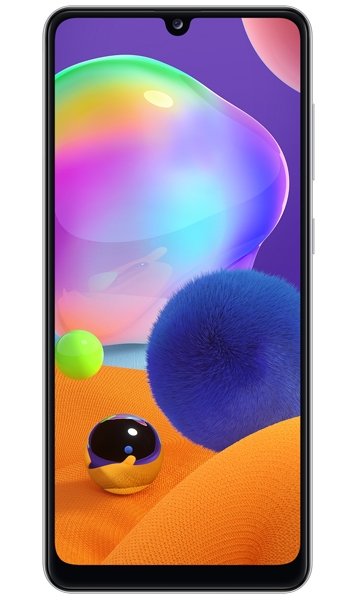Huawei nova Y70 Plus vs Samsung Galaxy A31 Comparison and Differences
Smartphone 1

Huawei nova Y70 Plus
Smartphone 2

Samsung Galaxy A31
Smartphone 3
Huawei nova Y70 Plus or Samsung Galaxy A31 Specs Comparison
or
 Common specs
Common specs
| Brand and model | Huawei nova Y70 Plus | Samsung Galaxy A31 | |
| Rating | (+0) | (+0) | |
| Release date | 2022, April 20 | 2020, March 24 | |
| Dimensions (HxWxD) | 168.3 x 77.7 x 9 mm | 6.63 x 6.63 x 3.06 in | 159.3 x 73.1 x 8.6 mm | 6.27 x 6.27 x 2.88 in | |
| Weight | 199 g | 7.02 oz | 185 g | 6.53 oz | |
| Case | buy from Amazon | buy from Amazon | |
| Colors | Crystal Blue, Midnight Black, Pearl White | Prism Crush Black, Prism Crush Blue, Prism Crush Red, Prism Crush White | |
| Battery | 6000 mAh, Li-Po, non-removable | 5000 mAh, Non-removable Li-Po | |
| Approximate price | 200 EUR | 220 EUR | |
| Check price | from Amazon | from Amazon |
 Screen
Screen
| Technology | IPS LCD | Super AMOLED | |
| Touchscreen | capacitive touchscreen | capacitive touchscreen | |
| Display colors | 16M | 16M | |
| Screen size | 6.75" in | 6.4" in | |
| Screen area | 110.0 cm2 | 98.9 cm2 | |
| Screen format | 20:9 (height:width) | 20:9 (height:width) | |
| Screen to body ratio | 84.1% | 84.9% | |
| Screen resolution | 720 x 1600 px | 1080 x 2400 px | |
| Screen PPI /points per inch/ | 260 PPI | 411 PPI | |
| Screen protector | buy from Amazon | buy from Amazon |
 Camera and Video
Camera and Video
| Rear camera, main | 48 MP, Triple | 48 MP, Quad | |
| Camera specs | -48 MP, f/1.8, 26mm (wide), PDAF -5 MP, f/2.2, 120˚ (ultrawide) -2 MP, f/2.4, (depth) |
-48 MP, f/2.0, 26mm (wide), 1/2.0", 0.8µm, PDAF -8 MP, f/2.2, 123˚, (ultrawide), 1/4.0", 1.12µm -5 MP, f/2.4, (macro) -5 MP, f/2.4, (depth) |
|
| Functions | LED flash, HDR, panorama | LED flash, panorama, HDR | |
| Video | 1080p@30fps | 1080p@30fps | |
| Front camera, selfie | 8 MP, Single | 20 MP, Single | |
| Specifications | 8 MP, f/2.0 | 20 MP, f/2.2, (wide) | |
| Functions | HDR | ||
| Video | 1080p@30fps | 1080p@30fps |
 Performance
Performance
| Operating system - OS | EMUI 12, no Google Play Services | Android 10.0; One UI 2.0 | |
| Chipset | - Mediatek MT6768 Helio P65 (12nm) | ||
| CPU | - Octa-core (2x2.0 GHz Cortex-A75 & 6x1.7 GHz Cortex-A55) | ||
| GPU | Mali-G52 MC2 | ||
| External memory | microSDXC (uses shared SIM slot) | microSDXC (dedicated slot) | |
| Internal memory | 128GB 4GB RAM | 64GB 4GB RAM, 128GB 4GB RAM, 128GB 6GB RAM |
 Benchmark
Benchmark
| Antutu 9 Total | 103023 | ||
| Antutu 8 Total | 183452 | ||
| GeekBench 6 Single Core | 386 | ||
| GeekBench 6 Multi Core | 1213 | ||
| GeekBench 6 OpenCL | 761 | ||
| GeekBench 5 Single Core | 171 | 326 | |
| GeekBench 5 Multi-Core | 978 | 1157 |
 Communication and Connectivity
Communication and Connectivity
| SIM card | Single SIM (Nano-SIM)Dual SIM (Nano-SIM, dual stand-by) | Single SIM (Nano-SIM)Dual SIM (Nano-SIM, dual stand-by) | |
| Network | GSM / HSPA / LTE | GSM / HSPA / LTE | |
| Bands | -2G - GSM 850 / 900 / 1800 / 1900 - SIM 1 & SIM 2 (dual-SIM) -3G - HSDPA 850 / 900 / 1900 / 2100 -4G - 1, 3, 5, 7, 8, 20, 28, 38, 40, 41 |
-2G - GSM 850 / 900 / 1800 / 1900 - SIM 1 & SIM 2 (dual-SIM model only) -3G - HSDPA 850 / 900 / 1900 / 2100 -4G - LTE (unspecified) |
|
| Speed | HSPA 42.2/5.76 Mbps, LTE | HSPA, LTE-A | |
| GPRS | Yes | Yes | |
| Edge | Yes | Yes | |
| Wi-Fi | Wi-Fi 802.11 b/g/n, hotspot | Wi-Fi 802.11 a/b/g/n/ac, dual-band, Wi-Fi Direct, hotspot | |
| GPS | Yes, with A-GPS, GLONASS, GALILEO, BDS, QZSS | Yes, with A-GPS, GLONASS, GALILEO, BDS | |
| NFC | No | Yes (market/region dependent) | |
| USB | USB Type-C 2.0, USB On-The-Go | 2.0, Type-C 1.0 reversible connector, USB On-The-Go | |
| Bluetooth | 5.1, A2DP, LE | 5.0, A2DP, LE | |
| Harmful irradiation |
SAR EU - 0.49 W/kg (head) 1.68 W/kg (body) |
 Music and Audio
Music and Audio
| Radio | No | FM radio, RDS, recording | |
| Headphone jack | Yes | Yes |
 Other features
Other features
| Sensors | - Fingerprint (side-mounted), accelerometer, proximity, compass | - Fingerprint (under display, optical), accelerometer, gyro, proximity, compass | |
| Other extras |
- Fast charging 22.5W |
- Fast charging 15W |
Reviews and Opinions on Huawei nova Y70 Plus and Samsung Galaxy A31
If you had to recommend one of these phones to a friend, which one would it be and why? Share your arguments using the Add Opinion button!
